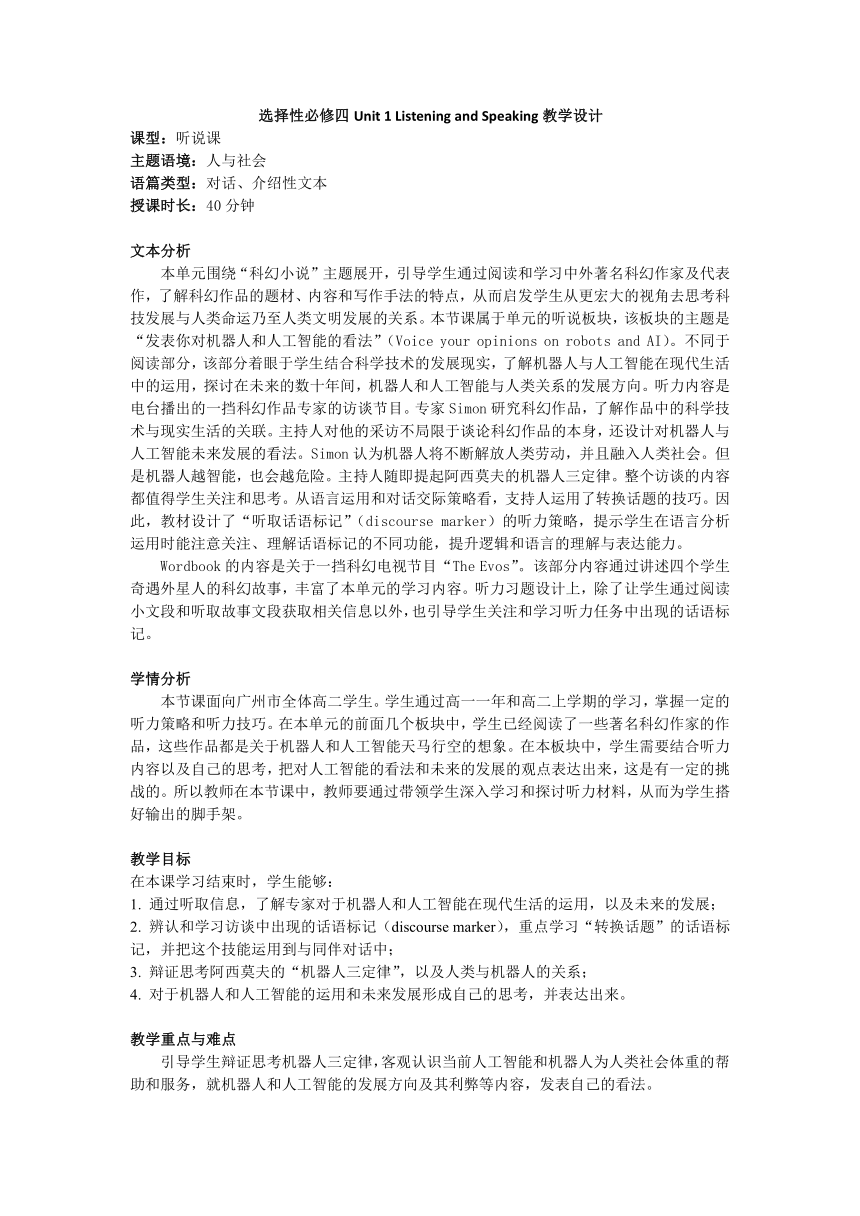Unit 1 Science Fiction Listening and Speaking-教案(表格式)人教版(2019)选择性必修 第四册
文档属性
| 名称 | Unit 1 Science Fiction Listening and Speaking-教案(表格式)人教版(2019)选择性必修 第四册 |  | |
| 格式 | doc | ||
| 文件大小 | 39.5KB | ||
| 资源类型 | 教案 | ||
| 版本资源 | 人教版(2019) | ||
| 科目 | 英语 | ||
| 更新时间 | 2025-03-07 13:49:44 | ||
图片预览

文档简介
选择性必修四Unit 1 Listening and Speaking教学设计
课型:听说课
主题语境:人与社会
语篇类型:对话、介绍性文本
授课时长:40分钟
文本分析
本单元围绕“科幻小说”主题展开,引导学生通过阅读和学习中外著名科幻作家及代表作,了解科幻作品的题材、内容和写作手法的特点,从而启发学生从更宏大的视角去思考科技发展与人类命运乃至人类文明发展的关系。本节课属于单元的听说板块,该板块的主题是“发表你对机器人和人工智能的看法”(Voice your opinions on robots and AI)。不同于阅读部分,该部分着眼于学生结合科学技术的发展现实,了解机器人与人工智能在现代生活中的运用,探讨在未来的数十年间,机器人和人工智能与人类关系的发展方向。听力内容是电台播出的一挡科幻作品专家的访谈节目。专家Simon研究科幻作品,了解作品中的科学技术与现实生活的关联。主持人对他的采访不局限于谈论科幻作品的本身,还设计对机器人与人工智能未来发展的看法。Simon认为机器人将不断解放人类劳动,并且融入人类社会。但是机器人越智能,也会越危险。主持人随即提起阿西莫夫的机器人三定律。整个访谈的内容都值得学生关注和思考。从语言运用和对话交际策略看,支持人运用了转换话题的技巧。因此,教材设计了“听取话语标记”(discourse marker)的听力策略,提示学生在语言分析运用时能注意关注、理解话语标记的不同功能,提升逻辑和语言的理解与表达能力。
Wordbook的内容是关于一挡科幻电视节目“The Evos”。该部分内容通过讲述四个学生奇遇外星人的科幻故事,丰富了本单元的学习内容。听力习题设计上,除了让学生通过阅读小文段和听取故事文段获取相关信息以外,也引导学生关注和学习听力任务中出现的话语标记。
学情分析
本节课面向广州市全体高二学生。学生通过高一一年和高二上学期的学习,掌握一定的听力策略和听力技巧。在本单元的前面几个板块中,学生已经阅读了一些著名科幻作家的作品,这些作品都是关于机器人和人工智能天马行空的想象。在本板块中,学生需要结合听力内容以及自己的思考,把对人工智能的看法和未来的发展的观点表达出来,这是有一定的挑战的。所以教师在本节课中,教师要通过带领学生深入学习和探讨听力材料,从而为学生搭好输出的脚手架。
教学目标
在本课学习结束时,学生能够:
通过听取信息,了解专家对于机器人和人工智能在现代生活的运用,以及未来的发展;
辨认和学习访谈中出现的话语标记(discourse marker),重点学习“转换话题”的话语标记,并把这个技能运用到与同伴对话中;
辩证思考阿西莫夫的“机器人三定律”,以及人类与机器人的关系;
对于机器人和人工智能的运用和未来发展形成自己的思考,并表达出来。
教学重点与难点
引导学生辩证思考机器人三定律,客观认识当前人工智能和机器人为人类社会体重的帮助和服务,就机器人和人工智能的发展方向及其利弊等内容,发表自己的看法。
教学资源
教材、多媒体课件、多媒体设备。
教学过程
步骤 教学活动 设计意图
Warming up
Step 1 T ask Ss to watch a video about robots in China International Import Expo (CIIE) in 2021 and answer two questions:①What robots’ jobs are mentioned in the video ②What’s the reporter’s comments on the robots and AI 通过观看与自己国家和现代生活息息相关的热点新闻视频,激发学生对于机器人和人工智能这个话题的兴趣。
Pre-listening
Step 2 T shows the pictures of robots doing different jobs to Ss, asks them to talk about the jobs and their pros and cons.T guides the students to talk about the robots they hope for. 通过展示机器人从事不同工作的图片,引导他们用英语表达工作内容,讨论机器人从事这些工作的利弊,以及他们心目中理想的机器人。
While-listening
Task 1 T asks Ss to listen to the interview and answer the following questions:Who is interviewed What questions did the host ask about robots and AI 通过Task 1,学生在第一次听的时候,快速抓住主持人问专家的五个问题;从而对整个访谈的内容有个大致了解;Task 2聚焦的是专家对主持人提问的回答,体现了他对于机器人和人工智能的看法。获取这些信息对后面的输出做好铺垫。
Task 2 T guides Ss to focus on the experts’ opinions in the second listening. After the listening, Ss answer the following questions.①What does the expert think about the benefits and problems that robots and AI will bring ②In the expert’s opinion, what should we do to tackle the problems ③What does the expert think about the future relationship between robots and humans
Task 3 T asks Ss to discuss the Issac Asimov’s three laws of Robotics with the following question.“Is there contradictions among these laws ” 让学生通过思考阿西莫夫的机器人三大定律的矛盾点,对人类和机器人的关系形成自己的思考,锻炼批判性思维。
Task 4 1.T guides Ss to comprehend the definition of “discourse marker” and find out the discourse markers in the interview through the third listening. 2.T guides Ss to focus on discourse markers of “changing topics” in the interview.3.T gets Ss to learn more discourse markers of “changing topics”. 让学生了解认识什么是话语标记,并且训练他们在访谈中找出这些标记,尤其关注“转换话题”的标记词,为对话输出做好铺垫。
Post-listening
Step 1 T asks Ss to discuss the Issac Asimov’s three laws of Robotics with the following question.“Is there contradictions among these laws ” 让学生通过思考阿西莫夫的机器人三大定律的矛盾点,对人类和机器人的关系形成自己的思考,锻炼批判性思维。
Step 2 T gets Ss to make a dialogue by using discourse markers learned in Task 3, centering on the following questions.①What do you know about robot technology What can robots do ②What benefits do you think robots or AI will bring Do you think they will cause problems as well ③Do you know anything about Isaac Asimov and his famous Three Laws of Robotics What do you think of these laws 引导学生通过讨论和同伴互助,再次加工信息点后通过真实任务进行口头输出,对所听内容进行内化,运用所学的“话语标记”,提升语言综合运用能力。 。
Step 3 T presents a sample dialogue and guides Ss to find out the discourse markers in it.
Summarizing
T guides to students to review what they have learned in this lesson. 引导学生总结所学内容,并进行内化
Assignment
1.Surf the Internet and learn more about more discourse markers in both oral and written English;2.Write a short passage to express your opinion on whether humans should further develop robots and AI technology.
备注:
Ss: Students T: Teacher
课型:听说课
主题语境:人与社会
语篇类型:对话、介绍性文本
授课时长:40分钟
文本分析
本单元围绕“科幻小说”主题展开,引导学生通过阅读和学习中外著名科幻作家及代表作,了解科幻作品的题材、内容和写作手法的特点,从而启发学生从更宏大的视角去思考科技发展与人类命运乃至人类文明发展的关系。本节课属于单元的听说板块,该板块的主题是“发表你对机器人和人工智能的看法”(Voice your opinions on robots and AI)。不同于阅读部分,该部分着眼于学生结合科学技术的发展现实,了解机器人与人工智能在现代生活中的运用,探讨在未来的数十年间,机器人和人工智能与人类关系的发展方向。听力内容是电台播出的一挡科幻作品专家的访谈节目。专家Simon研究科幻作品,了解作品中的科学技术与现实生活的关联。主持人对他的采访不局限于谈论科幻作品的本身,还设计对机器人与人工智能未来发展的看法。Simon认为机器人将不断解放人类劳动,并且融入人类社会。但是机器人越智能,也会越危险。主持人随即提起阿西莫夫的机器人三定律。整个访谈的内容都值得学生关注和思考。从语言运用和对话交际策略看,支持人运用了转换话题的技巧。因此,教材设计了“听取话语标记”(discourse marker)的听力策略,提示学生在语言分析运用时能注意关注、理解话语标记的不同功能,提升逻辑和语言的理解与表达能力。
Wordbook的内容是关于一挡科幻电视节目“The Evos”。该部分内容通过讲述四个学生奇遇外星人的科幻故事,丰富了本单元的学习内容。听力习题设计上,除了让学生通过阅读小文段和听取故事文段获取相关信息以外,也引导学生关注和学习听力任务中出现的话语标记。
学情分析
本节课面向广州市全体高二学生。学生通过高一一年和高二上学期的学习,掌握一定的听力策略和听力技巧。在本单元的前面几个板块中,学生已经阅读了一些著名科幻作家的作品,这些作品都是关于机器人和人工智能天马行空的想象。在本板块中,学生需要结合听力内容以及自己的思考,把对人工智能的看法和未来的发展的观点表达出来,这是有一定的挑战的。所以教师在本节课中,教师要通过带领学生深入学习和探讨听力材料,从而为学生搭好输出的脚手架。
教学目标
在本课学习结束时,学生能够:
通过听取信息,了解专家对于机器人和人工智能在现代生活的运用,以及未来的发展;
辨认和学习访谈中出现的话语标记(discourse marker),重点学习“转换话题”的话语标记,并把这个技能运用到与同伴对话中;
辩证思考阿西莫夫的“机器人三定律”,以及人类与机器人的关系;
对于机器人和人工智能的运用和未来发展形成自己的思考,并表达出来。
教学重点与难点
引导学生辩证思考机器人三定律,客观认识当前人工智能和机器人为人类社会体重的帮助和服务,就机器人和人工智能的发展方向及其利弊等内容,发表自己的看法。
教学资源
教材、多媒体课件、多媒体设备。
教学过程
步骤 教学活动 设计意图
Warming up
Step 1 T ask Ss to watch a video about robots in China International Import Expo (CIIE) in 2021 and answer two questions:①What robots’ jobs are mentioned in the video ②What’s the reporter’s comments on the robots and AI 通过观看与自己国家和现代生活息息相关的热点新闻视频,激发学生对于机器人和人工智能这个话题的兴趣。
Pre-listening
Step 2 T shows the pictures of robots doing different jobs to Ss, asks them to talk about the jobs and their pros and cons.T guides the students to talk about the robots they hope for. 通过展示机器人从事不同工作的图片,引导他们用英语表达工作内容,讨论机器人从事这些工作的利弊,以及他们心目中理想的机器人。
While-listening
Task 1 T asks Ss to listen to the interview and answer the following questions:Who is interviewed What questions did the host ask about robots and AI 通过Task 1,学生在第一次听的时候,快速抓住主持人问专家的五个问题;从而对整个访谈的内容有个大致了解;Task 2聚焦的是专家对主持人提问的回答,体现了他对于机器人和人工智能的看法。获取这些信息对后面的输出做好铺垫。
Task 2 T guides Ss to focus on the experts’ opinions in the second listening. After the listening, Ss answer the following questions.①What does the expert think about the benefits and problems that robots and AI will bring ②In the expert’s opinion, what should we do to tackle the problems ③What does the expert think about the future relationship between robots and humans
Task 3 T asks Ss to discuss the Issac Asimov’s three laws of Robotics with the following question.“Is there contradictions among these laws ” 让学生通过思考阿西莫夫的机器人三大定律的矛盾点,对人类和机器人的关系形成自己的思考,锻炼批判性思维。
Task 4 1.T guides Ss to comprehend the definition of “discourse marker” and find out the discourse markers in the interview through the third listening. 2.T guides Ss to focus on discourse markers of “changing topics” in the interview.3.T gets Ss to learn more discourse markers of “changing topics”. 让学生了解认识什么是话语标记,并且训练他们在访谈中找出这些标记,尤其关注“转换话题”的标记词,为对话输出做好铺垫。
Post-listening
Step 1 T asks Ss to discuss the Issac Asimov’s three laws of Robotics with the following question.“Is there contradictions among these laws ” 让学生通过思考阿西莫夫的机器人三大定律的矛盾点,对人类和机器人的关系形成自己的思考,锻炼批判性思维。
Step 2 T gets Ss to make a dialogue by using discourse markers learned in Task 3, centering on the following questions.①What do you know about robot technology What can robots do ②What benefits do you think robots or AI will bring Do you think they will cause problems as well ③Do you know anything about Isaac Asimov and his famous Three Laws of Robotics What do you think of these laws 引导学生通过讨论和同伴互助,再次加工信息点后通过真实任务进行口头输出,对所听内容进行内化,运用所学的“话语标记”,提升语言综合运用能力。 。
Step 3 T presents a sample dialogue and guides Ss to find out the discourse markers in it.
Summarizing
T guides to students to review what they have learned in this lesson. 引导学生总结所学内容,并进行内化
Assignment
1.Surf the Internet and learn more about more discourse markers in both oral and written English;2.Write a short passage to express your opinion on whether humans should further develop robots and AI technology.
备注:
Ss: Students T: Teacher
